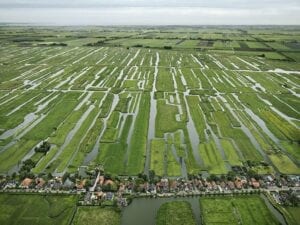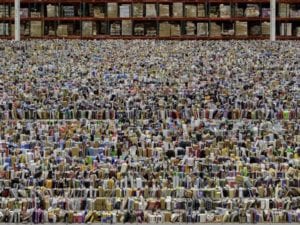Rows of solar panels encase the hillside, overseen by grey mountains in the distance. Typically, these natural monoliths would represent the might and magnitude of nature, yet here they only peek out from the background. This photograph, Les Mées (2016), makes human-made structures the focus by presenting the Les Mées Solar Farm, where over 112,000 solar modules cover 200 hectares of French countryside.

Andreas Gursky (b. 1955) rose to prominence in the 1990s for his large-scale photography. The image Salerno I (1990) marked a pivotal departure from his previous shots of people. Instead, a vast number of cars, cranes and shipping containers occupy the foreground of the frame. Despite its enormous scope, everything within the composition appears in vivid detail, inviting viewers to look deeper. Gursky’s prolific career has taken him around the world, from Hong Kong to Monaco and Qatar. Wherever he goes, his lens is focused on markers of industry, which serve as indicators of civilisation and dominance over landscape.

The “industrial aesthetic” is a hallmark of Gursky’s oeuvre, gaining new relevance at a time of climate awareness. These interests match Fondazione MAST’s mission to unify technology and art, making it the perfect setting for his Italian debut with Visual Spaces of Today. The show presents 40 images from a three-decade career. The artist says: “All my landscapes are manmade. My interest lies in people, civilisation, human presence and activity. I couldn’t imagine taking a photograph of a mountain just by itself.”
Fondazione MAST, Bologna: Visual Spaces of Today | Until 7 January
Words: Diana Bestwish Tetteh
Image Credits:
- Andreas Gursky, Les Mées, 1996 © ANDREAS GURSKY, by SIAE 2023 Courtesy: Sprüth Magers.
- Andreas Gursky, Salinas, 2021 © ANDREAS GURSKY, by SIAE 2023, Courtesy: Sprüth Magers.
- Andreas Gursky, Amazon, 2016 © ANDREAS GURSKY, by SIAE 2023 Courtesy: Sprüth Magers.





